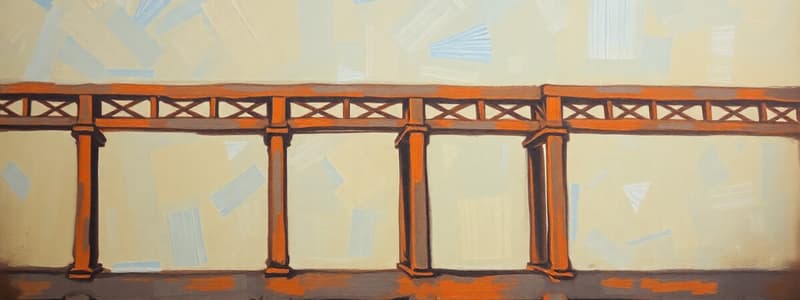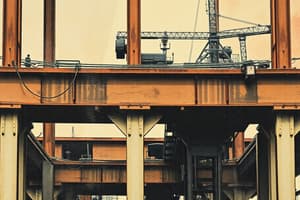Podcast
Questions and Answers
What type of frame exists in a two-dimensional plane with members lying in the same plane?
What type of frame exists in a two-dimensional plane with members lying in the same plane?
- Two-dimensional Frame (correct)
- Composite Frame
- Rigid Frame
- Three-dimensional Frame
In rigid-jointed frames, what forces do the structural members primarily carry?
In rigid-jointed frames, what forces do the structural members primarily carry?
- Only axial force
- Bending moment, shear force, and axial force (correct)
- Shear force and bending moment
- Bending moment and compressive force
Which of the following best describes three-dimensional frames in structural engineering?
Which of the following best describes three-dimensional frames in structural engineering?
- Frames that exist in three-dimensional space (correct)
- Frames that require only simple joint connections
- Frames that are limited to the x and y directions only
- Frames that can only support compression
What is a critical component when drawing a Free Body Diagram (FBD) for pin-jointed frames?
What is a critical component when drawing a Free Body Diagram (FBD) for pin-jointed frames?
How do the forces in two-dimensional frames primarily get analyzed?
How do the forces in two-dimensional frames primarily get analyzed?
What is the relationship between stress and thermal strain in the context of the bar's deformation?
What is the relationship between stress and thermal strain in the context of the bar's deformation?
What does the bracketed data for tensile strength refer to in brittle materials?
What does the bracketed data for tensile strength refer to in brittle materials?
At what condition does the bar yield according to the described yield condition?
At what condition does the bar yield according to the described yield condition?
If the temperature changes from T0 to T, what is ΔT in the given equations?
If the temperature changes from T0 to T, what is ΔT in the given equations?
What makes up the central nucleus of an atom?
What makes up the central nucleus of an atom?
What does the total strain in the bar equal when both mechanical and thermal strains are considered?
What does the total strain in the bar equal when both mechanical and thermal strains are considered?
The equation σ = -EαΔT indicates that stress is related to which of the following factors?
The equation σ = -EαΔT indicates that stress is related to which of the following factors?
Which characteristic of electrons describes their behavior around the nucleus?
Which characteristic of electrons describes their behavior around the nucleus?
What primarily contributes to the mass of an atom?
What primarily contributes to the mass of an atom?
Which property focuses on the atomic arrangement in materials as discussed in the upcoming topics?
Which property focuses on the atomic arrangement in materials as discussed in the upcoming topics?
What is the yielding temperature ΔTy in relation to thermal strain and yield strength?
What is the yielding temperature ΔTy in relation to thermal strain and yield strength?
What is the typical distance between atoms in a solid?
What is the typical distance between atoms in a solid?
Which two forces are involved when atoms are in proximity?
Which two forces are involved when atoms are in proximity?
What keeps electrons in the vicinity of the nucleus?
What keeps electrons in the vicinity of the nucleus?
In the ionic bond between sodium and chlorine, what is being shared?
In the ionic bond between sodium and chlorine, what is being shared?
How do atoms in a typical solid relate in terms of volume?
How do atoms in a typical solid relate in terms of volume?
What are trusses primarily designed to carry?
What are trusses primarily designed to carry?
What type of force do struts primarily resist?
What type of force do struts primarily resist?
What is the primary function of beams in structural design?
What is the primary function of beams in structural design?
Columns are designed to support which type of loads?
Columns are designed to support which type of loads?
Which of the following structural elements are NOT designed to carry axial loads?
Which of the following structural elements are NOT designed to carry axial loads?
What is the role of a moment in structural design?
What is the role of a moment in structural design?
What primarily characterizes a strut?
What primarily characterizes a strut?
Which aspect differentiates beams from columns?
Which aspect differentiates beams from columns?
What type of strain is caused by loading perpendicular to the surface of an object?
What type of strain is caused by loading perpendicular to the surface of an object?
Which Greek letter denotes normal strain?
Which Greek letter denotes normal strain?
What is the formula for calculating thermal strain?
What is the formula for calculating thermal strain?
What happens to the sign of strain when the length of a rod increases?
What happens to the sign of strain when the length of a rod increases?
Which type of stress causes shear strain in a material?
Which type of stress causes shear strain in a material?
What does the coefficient of thermal expansion (𝛼) represent?
What does the coefficient of thermal expansion (𝛼) represent?
What type of strain is specifically termed 'mechanical strain'?
What type of strain is specifically termed 'mechanical strain'?
What happens to materials in the linear elastic region when the applied load is removed?
What happens to materials in the linear elastic region when the applied load is removed?
Which of the following scenarios could lead to a negative strain?
Which of the following scenarios could lead to a negative strain?
What is the expression for normal stress-strain according to Hooke's Law?
What is the expression for normal stress-strain according to Hooke's Law?
Which statement is true regarding elastic modulus?
Which statement is true regarding elastic modulus?
Which of the following describes the shear modulus?
Which of the following describes the shear modulus?
In the behavior of materials, what is the elastic limit?
In the behavior of materials, what is the elastic limit?
What is represented by the parameter 𝐸𝐸 in the stress-strain relationship?
What is represented by the parameter 𝐸𝐸 in the stress-strain relationship?
What does Hooke's Law assume about the relationship between stress and strain?
What does Hooke's Law assume about the relationship between stress and strain?
Which of the following affects the elastic (Young’s) modulus of a material?
Which of the following affects the elastic (Young’s) modulus of a material?
Flashcards
Tension
Tension
The ability of a material to resist being stretched or pulled apart.
Compression
Compression
The ability of a material to resist being compressed or squeezed.
Bending
Bending
A force that causes a material to bend or deform.
Shear
Shear
Signup and view all the flashcards
Torsion
Torsion
Signup and view all the flashcards
Truss
Truss
Signup and view all the flashcards
Strut
Strut
Signup and view all the flashcards
Beam
Beam
Signup and view all the flashcards
Two-dimensional (Planar) Frames
Two-dimensional (Planar) Frames
Signup and view all the flashcards
Three-dimensional (Space) Frames
Three-dimensional (Space) Frames
Signup and view all the flashcards
Free Body Diagram (FBD)
Free Body Diagram (FBD)
Signup and view all the flashcards
Pin Joint
Pin Joint
Signup and view all the flashcards
Rigid Joint
Rigid Joint
Signup and view all the flashcards
Normal Strain
Normal Strain
Signup and view all the flashcards
Normal Strain (Formula)
Normal Strain (Formula)
Signup and view all the flashcards
Shear Strain
Shear Strain
Signup and view all the flashcards
Mechanical Strain
Mechanical Strain
Signup and view all the flashcards
Thermal Strain
Thermal Strain
Signup and view all the flashcards
Thermal Strain (Formula)
Thermal Strain (Formula)
Signup and view all the flashcards
Thermal Expansion Coefficient ( Alpha )
Thermal Expansion Coefficient ( Alpha )
Signup and view all the flashcards
Environmental Strain
Environmental Strain
Signup and view all the flashcards
Elasticity
Elasticity
Signup and view all the flashcards
Elastic Limit
Elastic Limit
Signup and view all the flashcards
Linear Elasticity
Linear Elasticity
Signup and view all the flashcards
Yield Point
Yield Point
Signup and view all the flashcards
Tensile Strength
Tensile Strength
Signup and view all the flashcards
Ductility
Ductility
Signup and view all the flashcards
Stress-Strain Curve
Stress-Strain Curve
Signup and view all the flashcards
Elastic Modulus (Young's Modulus)
Elastic Modulus (Young's Modulus)
Signup and view all the flashcards
Yield Strength (𝜎y)
Yield Strength (𝜎y)
Signup and view all the flashcards
Tensile Strength (𝜎TS)
Tensile Strength (𝜎TS)
Signup and view all the flashcards
Strain to Failure (εf)
Strain to Failure (εf)
Signup and view all the flashcards
Thermal Expansion Coefficient (α)
Thermal Expansion Coefficient (α)
Signup and view all the flashcards
Modulus of Rupture (𝜎r)
Modulus of Rupture (𝜎r)
Signup and view all the flashcards
Plastic Deformation
Plastic Deformation
Signup and view all the flashcards
Stress (𝜎)
Stress (𝜎)
Signup and view all the flashcards
Atomic Structure
Atomic Structure
Signup and view all the flashcards
Atoms
Atoms
Signup and view all the flashcards
Electron Behavior
Electron Behavior
Signup and view all the flashcards
Nucleus
Nucleus
Signup and view all the flashcards
Interatomic Forces
Interatomic Forces
Signup and view all the flashcards
Interatomic Bond
Interatomic Bond
Signup and view all the flashcards
Ionic Bond
Ionic Bond
Signup and view all the flashcards
Covalent Bond
Covalent Bond
Signup and view all the flashcards
Study Notes
Solid Mechanics Module (EG1031)
- The module covers the basics of Solid Mechanics and materials.
Module Outline
- What is Solid Mechanics?
- Why study Solid Mechanics?
- Examples and Applications
- Solid Mechanics in nutshell
- Solid Mechanics Module
- Structural Elements
- Next Lecture
Introduction to Solid Mechanics
- Solid mechanics (also known as mechanics of solids or mechanics of materials) is the branch of continuum mechanics that studies the behavior of solid materials, especially their deformation and failure under the action of forces, temperature changes, phase changes, and other external or internal agents.
- Key factors include solid components, different materials, different conditions, and predictions of deformation and failure.
Why study Solid Mechanics?
- Solid mechanics plays a pivotal role in engineering, technology, and science, impacting various industries and improving our daily lives.
- Essential for designing structures, machines, and systems to ensure safety, reliability, and efficiency across civil, aerospace, nuclear, biomedical, and mechanical engineering, as well as geology and various branches of physics and chemistry (like material science).
- Material optimization: Understanding material failure and deformation is critical for selecting the right material for specific applications.
- Driving innovation: Advances in materials and structures rely on solid mechanics principles.
- Ensuring safety: Safeguarding critical infrastructure like bridges, buildings, and aerospace components relies on these principles.
Examples and Applications
- Mechanical Engineering: Development of machinery, engines, and mechanical systems, optimizing components for strength, durability, and efficiency (including ship analysis and crash test simulations).
- Aerospace Engineering: Designing aircraft and spacecraft structures and evaluating materials for extreme conditions and structural integrity (including plane fuselage analysis).
- Structural Engineering: Designing and analyzing buildings, bridges, and infrastructure for safety and stability, ensuring load-bearing capacity and resistance to external forces (including terraced tower and bridge analysis).
- Material Science: Investigating material properties (elasticity, plasticity, and fracture mechanics) and developing new materials with improved characteristics (including crack growth and creep failure analysis).
- Biomechanics: Studying the mechanics of biological tissues and prosthetic devices, advancing medical implants and orthopaedic solutions (including knee and spine disc analysis).
Solid Mechanics in Nutshell
- A diagram illustrating Structures, Solid Mechanics, and Materials as interconnected components of Solid Mechanics.
Solid Mechanics Module Specifications
- 15 credits module.
- 22 Lectures (Mondays 9-11am, excluding weeks 11 and 12).
- 11 Workshops (including: 2 experiments (weeks 14-16 and 18-20), and 9 practical sessions (Thursdays 3-4pm, starting from week 13).
- Assessment:
- Practical assignments (20%).
- Examination (80%).
- Re-assessment: examination only (100%).
Intended Learning Outcomes (ILOs)
- Articulate an understanding of the basic principles of solid mechanics and the mechanics of materials with applications to mechanical and aerospace systems and mechanisms.
- Demonstrate analytical understanding of different types of problems encountered in the design of mechanical and aerospace systems and mechanisms; identify and apply the required theory.
- Interpret data and perform fundamental design calculations across the fields of material properties, structural mechanics, and mechanics of machines.
- Describe the main properties and characteristics of practical materials.
- Have a good grasp of the principles of equilibrium (fundamental to all mechanical problems).
- Be familiar with the concepts of force, moment, reaction, and sign conventions.
- Understand how applied loads and support conditions are idealized in structural analysis.
- Be able to draw free body diagrams and calculate forces in simple planar structures.
- Know the difference between internal and external forces.
- Be able to classify a general structure into statically determinate, statically indeterminate, or mechanisms.
Learning Materials
- Lecture and practical sessions notes
- Recommended reference books (e.g., P.P. Benham, R.J. Crawford, C.G. Armstrong; M.F. Ashby and D.R.H. Jones).
- Online materials
Teaching Plan
- Topics covered in the Module:
- Structures: (Trusses, Frames, Beams, Shafts, 2D Solids)
- Materials: (Atoms, molecules, crystals, types of materials, origin of elasticity, plasticity, failure)
- Response: (Stress and strain, Hooke's law, Tresca's criterion, elongation of bars, bending of beams, twisting of shafts, failure)
Structure
- A structure transmits load, usually from one place to another (typically the ground).
- Structural elements bear primary loads and provide structural support and/or enhance stability, aesthetics, or functionality.
Force and Moment
- A force is a vector quantity that changes an object's velocity (i.e., accelerates) or deforms it, unless counterbalanced by other forces.
- A moment is a vector quantity that quantifies the rotational effect of a force about a specific point or axis.
How do structures carry loads?
Methods of load carrying:
- Tension
- Compression
- Bending
- Shear
- Torsion
Structural Elements
- Trusses: composed of straight members (bars) connected at their ends by pin joints, designed to carry only axial loads.
- Struts: structural components designed to resist axial compression forces, used for pushing or bracing elements together.
- Beams: carry loads applied perpendicular to their longitudinal axis, distributing loads as bending moments and shear forces along their length (e.g., concrete and wooden buildings).
- Columns: vertical elements supporting compressive loads primarily acting along their longitudinal axis (e.g., concrete and wooden buildings).
- Cables: slender, flexible, tension-only elements resisting axial loads primarily in tension (e.g., in stadiums and bridges).
- Ties: structural components resisting axial tension forces, keeping two or more components together by pulling them in tension (example in London eye).
- Arches: curved structural elements supporting loads primarily through axial compression.
- Shafts: cylindrical or rod-like mechanical components transmitting rotational motion and torque (e.g., in gears, and car axles).
- Plates: two-dimensional elements with small thickness, carrying loads primarily through bending and flexural deformation .
- Shells: three-dimensional elements with curved geometries (spheres or cylinders) carrying loads through membrane action (tension or compression across the surface) and bending.
Further details on specific topics can be found in the corresponding lectures.
Studying That Suits You
Use AI to generate personalized quizzes and flashcards to suit your learning preferences.




